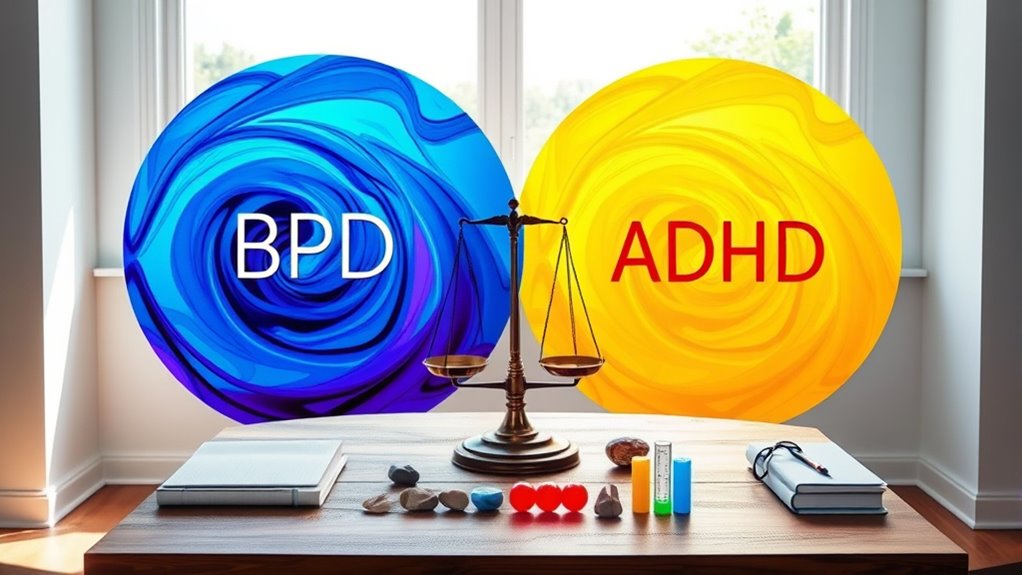Managing BPD and ADHD together can be challenging because these conditions share symptoms like impulsivity, emotional swings, and concentration difficulties. To handle both effectively, it is crucial to get accurate diagnosis, use tailored therapies like DBT and CBT, and consider medication carefully. Building a strong support system and developing healthy routines also make a difference. If you want to learn strategies to navigate this complex situation, there’s more you can explore below.
Key Takeaways
- Implement personalized treatment plans combining medication, psychotherapy (like DBT and CBT), and lifestyle adjustments for both conditions.
- Regularly monitor symptoms to adapt interventions and address overlapping challenges such as impulsivity and emotional instability.
- Develop coping strategies and emotional regulation skills through therapy to manage complex emotional responses.
- Build a strong support system with family, friends, and mental health professionals to provide stability and understanding.
- Educate oneself about both disorders to foster awareness, reduce stigma, and improve management efforts.
Understanding the Connection Between BPD and ADHD

Understanding the connection between BPD and ADHD reveals that these disorders often overlap due to shared risk factors and symptom patterns. You might notice that both conditions can involve impulsivity and emotional challenges, which complicates diagnosis. Early-life adverse events, like trauma or neglect, increase the likelihood of developing either disorder, highlighting their common environmental roots. Genetics also play a role, as both share some inherited risk factors that influence brain development and temperament. These overlaps mean that when you experience symptoms of one, the other might also be present, making clinical assessment more complex. Recognizing these shared elements helps clinicians approach diagnosis and treatment with a broader perspective, emphasizing the importance of considering both disorders in tandem for effective management. Additionally, research into neurobiological factors suggests that disruptions in brain circuits related to emotion regulation and impulse control are common to both conditions. Moreover, advances in neuroimaging techniques are enhancing our understanding of how these shared neural pathways contribute to symptom overlap, aiding in more accurate diagnosis and personalized treatment options. Exploring neuroplasticity may provide new avenues for intervention by promoting adaptive brain changes, which can be particularly beneficial in treating co-occurring disorders. Understanding these neurobiological connections can also inform targeted therapies aimed at addressing underlying brain function rather than just symptoms. Furthermore, environmental influences such as trauma exposure can significantly impact the development of neural pathways involved in both conditions, underscoring the importance of comprehensive treatment approaches.
Recognizing Shared Symptoms and Overlap

Recognizing shared symptoms between BPD and ADHD can be challenging because both disorders often display similar behaviors, such as impulsivity and emotional dysregulation. You might notice impulsive actions in both conditions, like interrupting others with ADHD or self-harm in BPD. Emotional reactions tend to be intense in either case, often linked to fears of rejection or impulsive responses to stress. Relationship struggles are common—unstable in BPD and strained due to forgetfulness or focus issues in ADHD. Concentration difficulties also overlap: distraction in ADHD and emotional distress in BPD. Both share neuropsychological traits like novelty seeking and harm avoidance. These similarities can make it harder to distinguish between the two, requiring careful attention to nuanced differences. Additionally, understanding the concept of Free Floating can aid in recognizing how pervasive and diffuse symptoms may manifest across both conditions. Recognizing how neuropsychological traits influence behavior can help differentiate the underlying causes of symptoms and improve tailored treatment approaches. Being aware of shared neurobehavioral features can further assist clinicians in developing more effective, individualized management strategies. Moreover, considering emotional dysregulation patterns can provide deeper insights into the core challenges faced by individuals with these conditions.
Diagnosing Both Conditions Accurately

Accurately diagnosing both BPD and ADHD requires careful application of structured clinical assessments, as their overlapping symptoms can easily lead to misinterpretation. You need to use specific tools like Conners’ Rating Scales for ADHD and the Structured Clinical Interview for DSM for BPD. Gathering detailed developmental history helps differentiate early-onset ADHD from BPD’s later emergence. Multiple assessment methods, including self-report, informant reports, and collateral information, enhance accuracy. Be mindful of comorbidities like depression or anxiety, which can mask or mimic symptoms. Recognizing diagnostic challenges in differentiating these conditions is crucial for effective treatment planning. The table below summarizes key diagnostic features:
| Aspect | ADHD | BPD | Overlap/Challenges |
|---|---|---|---|
| Onset | Early childhood | Late adolescence/adulthood | Symptom timing can be ambiguous |
| Core features | Inattention, hyperactivity, impulsivity | Emotional dysregulation, unstable relationships | Shared impulsivity and emotional dysregulation |
| Assessment tools | Conners’ Scales, clinical interviews | Structured Clinical Interview for DSM | Multiple tools needed for accuracy |
| Developmental trajectory | Persistent across lifespan | Emerges in late adolescence, early adulthood | Overlapping impulsivity in both |
| Comorbidities | ADHD often coexists with other disorders | BPD often co-occurs with mood and substance use | Comorbidities complicate diagnosis |
Navigating Challenges in Identification

You may find it tricky to distinguish between ADHD and BPD because their symptoms often overlap, like impulsivity and emotional instability. This confusion can lead to missed or incorrect diagnoses, especially if factors like age and gender aren’t carefully considered. Recognizing these challenges is key to ensuring accurate identification and effective treatment. Accurate diagnosis is vital, since the two conditions require different treatment approaches and management strategies. For example, understanding how relationship dynamics influence symptom presentation can aid clinicians in making more precise assessments. Additionally, awareness of comorbidities can further complicate diagnosis, underscoring the importance of comprehensive evaluation. Considering environmental factors can also provide insights into symptom triggers and help tailor individualized treatment plans. Furthermore, understanding AI in Education and its impact on learning environments can be useful when considering how external influences might affect symptom expression and management. Being aware of diagnostic criteria ensures that clinicians differentiate accurately between the disorders, reducing the risk of misdiagnosis.
Symptom Overlap Confusion
Because BPD and ADHD share several core symptoms, distinguishing between them can be incredibly challenging for clinicians. Both conditions involve impulsivity, emotional dysregulation, and difficulty with focus, which can blur diagnostic lines. For instance, impulsivity in ADHD often appears as distractibility or hyperactivity, while in BPD, it may manifest through self-destructive behaviors or unstable relationships. Emotional instability is common to both, making it hard to tell if mood swings stem from BPD or ADHD-related frustration. Additionally, co-occurrence rates are high—up to 40%—and symptoms can overshadow each other, especially in women. This overlap often leads to misdiagnosis or delayed diagnosis, complicating treatment plans and affecting daily functioning. Careful symptom analysis and thorough assessments are essential. Research indicates a significant symptom overlap in symptoms, further complicating accurate diagnosis and effective treatment. Recognizing the shared features such as impulsivity and emotional dysregulation can aid clinicians in differentiating and managing these conditions more effectively. Moreover, understanding the neurobiological mechanisms underlying both disorders can provide deeper insights into tailored intervention strategies. A comprehensive understanding of comorbidities can also improve treatment outcomes by addressing multiple issues simultaneously. Additionally, awareness of diagnostic challenges can help clinicians avoid premature conclusions and ensure more accurate identification of each condition.
Diagnostic Oversights Risks
Charting the diagnostic process for individuals with overlapping BPD and ADHD symptoms presents significant challenges due to the complexity of distinguishing between the two. Shared symptoms like impulsivity and emotional dysregulation often blur diagnostic lines. You might rely on tools such as self-report scales, but these lack the specificity needed to differentiate conditions clearly. Accurate diagnosis is essential to ensure effective treatment and avoid unnecessary interventions. Misdiagnosis risks increase when:
- Inattention and organizational issues are masked by borderline symptoms
- Dissociative states mimic ADHD inattentiveness
- Comorbidities, like BED, complicate the clinical picture
- Diagnostic accuracy can be improved with comprehensive assessments and clinical judgment, reducing the likelihood of misclassification. Incorporating Glycolic acid benefits in assessment tools might also aid in understanding underlying skin-related comorbidities that can influence emotional regulation and self-image, which are relevant in both conditions.
These overlaps can lead to missed or incorrect diagnoses, delaying appropriate treatment. To mitigate this, clinicians must combine extensive assessments, behavioral observations, and careful review of medical history, emphasizing clinical judgment over sole reliance on screening tools. Incorporating auditory processing assessments can help identify specific sensory and cognitive challenges that influence symptom presentation, thereby improving diagnostic accuracy and sensory processing understanding. Additionally, understanding comorbidities such as BED is crucial for comprehensive treatment planning.
Gender and Age Factors
Gender and age substantially influence how symptoms of BPD and ADHD present, often complicating the diagnostic process. Women with BPD tend to show more intense emotional symptoms, while men often display higher antisocial tendencies. Females with ADHD often have inattentive symptoms that are less disruptive, leading to underdiagnosis compared to males, who typically exhibit overt hyperactivity. Adolescence and adulthood bring additional challenges, as BPD symptoms emerge later, making early differentiation from ADHD difficult. Hormonal fluctuations can also affect symptom severity, especially in females. Research indicates that hormonal changes during menstrual cycles can temporarily intensify ADHD and BPD symptoms, further complicating diagnosis. Additionally, the gender differences in symptom expression can influence both diagnosis and treatment approaches. Diagnosis may be delayed or missed entirely in older adults due to overlapping symptoms with other conditions. Recognizing these gender and age-related differences is vital for accurate diagnosis and effective treatment, ensuring neither condition goes unnoticed or undertreated.
Effective Treatment Strategies and Approaches

Effective treatment strategies for individuals with comorbid BPD and ADHD require a thorough, individualized approach that addresses the complex interplay of symptoms. You should combine medication, psychotherapy, and lifestyle adjustments to maximize outcomes. Medications like stimulants or mood stabilizers can target specific symptoms, but careful monitoring is essential due to potential side effects. Psychotherapeutic approaches, especially DBT and CBT, help develop emotional regulation, impulse control, and interpersonal skills. Additionally, lifestyle changes such as establishing routines, improving sleep, and reducing stress support treatment effectiveness. Medication options vary based on individual needs; experienced psychiatrists evaluate symptoms to develop personalized plans. Consider these strategies:
- Combining medication with tailored psychotherapy
- Implementing structured routines and stress management
- Regularly monitoring and adjusting treatment plans
This integrated approach helps manage both conditions effectively and promotes better functioning.
Addressing Comorbidities and Additional Risks

Addressing comorbidities and additional risks in individuals with both BPD and ADHD requires careful assessment and tailored interventions. You need to recognize the high prevalence of co-occurring conditions, such as substance use disorders, antisocial personality disorder, and obsessive-compulsive personality disorder. These concurrent conditions often amplify impulsivity, aggression, and psychosocial difficulties, making treatment more complex. Women with ADHD are more likely to have BPD, while men may display antisocial traits, influencing your approach. Be vigilant for higher risks of substance dependence, anger, and impulsive behaviors. Addressing these issues early and thoroughly can improve outcomes, reduce harm, and help manage the heightened risks associated with these overlapping disorders. Tailored strategies are essential to navigate this challenging clinical landscape effectively.
The Role of Behavioral and Pharmacological Therapies

Behavioral and pharmacological therapies play a crucial role in managing co-occurring BPD and ADHD by targeting core symptoms and emotional regulation challenges. These approaches work together to improve daily functioning and reduce impulsivity. You might find that Cognitive Behavioral Therapy (CBT) helps with ADHD symptoms and enhances overall functioning. Dialectical Behavior Therapy (DBT) is particularly useful for managing impulsivity and emotional instability related to BPD. Structured routines help keep ADHD symptoms in check, while psychosocial interventions support long-term symptom management. Group therapy offers peer support and understanding. Here’s a quick overview:
- CBT and DBT for symptom management and emotional regulation
- Structured routines to improve organization and focus
- Group therapy for support and shared experiences
Supporting Long-Term Management and Well-Being

Long-term management of co-occurring BPD and ADHD requires ongoing vigilance and adaptability to changing needs. Regularly assess symptoms to identify shifts and adjust treatment plans accordingly. Developing coping skills and emotional regulation techniques helps stabilize your mood and behavior over time. A multidisciplinary approach involving different specialists can improve outcomes and provide holistic support. Emphasizing lifestyle changes, like maintaining a healthy routine, complements therapy and medication. Remember, persistent ADHD symptoms and emotional instability can impact your quality of life, so consistent effort is key. Building resilience and a supportive environment enhances your well-being. Stay proactive, flexible, and engaged in your treatment journey to better manage both conditions and improve your overall quality of life.
Building a Support System for Better Outcomes

Building a strong support system is essential for managing co-occurring BPD and ADHD effectively. It helps reduce stigma, encourages open communication, and provides necessary guidance. Educate yourself about both conditions to foster empathy and understanding. Create a safe environment where you can openly discuss feelings and challenges. Involve mental health professionals like therapists and support groups to get specialized support. Establish clear boundaries to keep the support system healthy and sustainable. Prioritize your self-care to maintain your mental health, as supporting someone with BPD can be demanding. A solid support network includes:
- Family and friends assisting with practical tasks and emotional support
- Regular therapy sessions for ongoing guidance
- Trusted contacts during crises for immediate help
Frequently Asked Questions
How Do Gender Differences Influence BPD and ADHD Diagnosis?
You should be aware that gender differences influence how diagnoses are made. Women are often overdiagnosed with BPD due to biases, while men are more frequently diagnosed with ADHD because symptoms like hyperactivity are more recognized. These biases can lead to misdiagnosis or missed diagnoses. Recognizing how gender impacts symptoms and clinician perceptions helps you push for thorough assessments, avoid stereotypes, and make certain you receive accurate diagnoses and effective treatment.
Can Lifestyle Changes Significantly Improve Symptoms of Both Conditions?
You might wonder if lifestyle changes can really help manage symptoms. The answer is yes—adopting healthy habits like balanced eating, regular exercise, good sleep, and mindfulness can improve mood, focus, and emotional stability. Structured routines and self-care activities also boost your resilience. While they don’t replace therapy or medication, these adjustments support overall well-being and can lessen the severity of symptoms over time, making daily life more manageable.
Are There Specific Age-Related Factors Affecting Diagnosis Accuracy?
You should consider how age-related factors impact diagnosis accuracy because symptoms often overlap during adolescence, making it tricky to distinguish between conditions. Developmental stages, hormonal changes, and psychosocial influences can alter symptom presentation, leading to potential misdiagnosis. Additionally, diagnostic guidelines recommend waiting until adulthood for certain diagnoses like BPD, which complicates early identification. Being aware of these factors helps guarantee accurate assessment and timely, appropriate treatment.
How Does Comorbidity Impact Medication Effectiveness?
You might find that having both conditions makes medication effectiveness more complex. You need to carefully select and monitor treatments because symptoms overlap and can influence each other. While medications like mood stabilizers and ADHD drugs can help, responses vary, and some may increase risks like suicidal behavior. Personalizing your treatment plan and working closely with your healthcare provider guarantees you get the best possible outcomes.
What Are Emerging Therapies for Co-Occurring BPD and ADHD?
Emerging therapies focus on personalized approaches combining medication and psychotherapy. You might consider medications like methylphenidate or atomoxetine to target ADHD symptoms and emotional regulation challenges. Psychotherapeutic methods, especially Dialectical Behavior Therapy, help improve emotional regulation and impulsivity. Combining these treatments may enhance response, but ongoing research is essential. You should work closely with your healthcare provider to tailor interventions that address both conditions effectively, considering the latest emerging therapies.
Conclusion
Charting the path between BPD and ADHD can feel like walking a tightrope through a storm—challenging yet manageable. With understanding, the right strategies, and a strong support system, you can find stability amidst the chaos. Imagine anchoring yourself with tools and connections that keep you grounded, guiding you toward calmer waters. Remember, you’re not alone on this journey, and each step forward brings you closer to clearer skies and brighter days.









